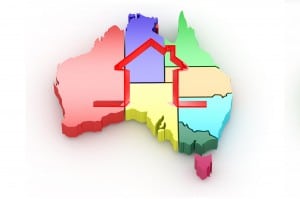2021: The year in review and what’s in store for 2022
As 2021 draws to a close, it’s an opportunity to take stock of the year that was and to review progress against expectations. While the year has been one riddled with lockdowns, restrictions and numerous COVID-related challenges, no matter where you might be in the country, there is no doubt 2021 has been defined by it’s financial strength and growth.
Ups and downs
Despite news that the national economy shrank 1.9 per cent in the September quarter, with Melbourne’s 111 day lockdown along with companion lockdowns in NSW and the ACT as significant driving factors, the pandemic hasn’t really been able to put a dent in the overall picture of strong health and growth for most of the national economy.
Over the year, the lockdowns may have dented spending and slowed GDP growth, but savings have accumulated strongly. The Treasurer, in his press conference delivering the national accounts, pointed to these savings as good news for future spending and thus economic growth.
House price growth
Undoubtedly, the star atop the Christmas tree for those who already own their own home, will be house price growth. This has delivered a handy Christmas bonus of unexpected levels of equity ready to be released and activated for anyone looking to leverage it.
Renovations have likely surged as a result of this growth.
Over the 12 months to November, CoreLogic data reveals that national house values have risen by 22 per cent, adding an average $126,700 to the median value of an Australian home.
ABS data reveals capital city house price growth has been record-breaking, with annual growth to the September quarter at these extraordinary levels:
Melbourne: 19.5%
Brisbane: 19.7%
Adelaide: 19.0%
Perth: 15.7%
Hobart: 25.7%
Darwin: 13.7%
Canberra: 25.2%
These growth percentage are head turning and have served as a clarion call to the federal regulators to pay closer attention to gains. Inevitably, with the housing market becoming less affordable, it is a generation of young people being locked out of the market.
APRA resisted consumer pressure throughout most of the year, but by September was unable to ignore the call for action and increased the assessable buffer from 2.5 per cent to 3.0 per cent. This means that when banks assess your application for a home loan, they assess your capacity to repay the loan as if it were 3.0 per cent higher than the actual rate you’ll be paying at. This builds in some room for borrowers if (when) rates eventually rise.
The end of the year represents some slowing of the pace of growth, but growth is still to be found. The slowdown is partly due to an increase of housing stock on the market, giving buyers more choice and more opportunities to find a property within their price band. It’s too early to tell if those rising stock levels will continue into 2022, but if so we’ll likely see buyers gaining more traction in the market as supply finally pumps the brakes on price growth.
Inflation, wages growth, employment data
Looking back over the past 12 months, with the cash rate sitting at 0.1 per cent, many could be forgiven for thinking the Reserve Bank of Australia Governor, Philip Lowe, had nodded off. The rate landed at 0.1 per cent in November 2020 and then didn’t move throughout the entire year.
Economic pundits have spent a year speculating about when the rates could move and what would make them move.
Lowe has been quite clear – wages growth of 2 to 3 per cent, inflation of 2 to 3 per cent and strong employment figures, are what’s required before the Board will consider a rate rise.
Throughout the year, those metrics have held stubbornly below the targets set by the RBA Board.
The national unemployment rate began the year at around 6.4 per cent, trended downwards steadily through to August, where it reached a low of 4.5 per cent, before trending up in September and landing at 5.2 per cent in October. Similarly the labour force participation rate has worsened slightly towards the end of the year, falling to 64.5 per cent in September, before ticking up slightly to 64.7 per cent in October.
These factors are unlikely to put the pressure required on wages to deliver the growth Lowe is looking for and with international borders likely to open soon, bringing fresh workers into the country, it’s difficult to see how this target will be reached in 2022.
Looking ahead to 2022
Next year, one of the big factors to worry about will be new variants of COVID and how they might impact the economy. It’s likely that, as vaccination rates approach 90 per cent, the effect will be less keenly felt than at the beginning of the pandemic. State leaders have all but ruled out extended lockdowns as a tool for managing the virus and this will allow the economy to continue to operate, which is good news for all, particularly in the most populous states of New South Wales, Victoria and Queensland.
Also, a federal election in either March or May (I’m tipping May) next year will also be a factor to consider. House market turnover typically slows in the lead-up to an election so real estate agents will be bracing for a slowdown. April is typically a slower month due to Easter, so a May election would work well for the real estate sector, potentially.
Finally, when looking ahead, it’s important to understand that it is those people who have a plan for their personal wealth growth weather these ups and downs best. Yes, you must adapt and flex in response to the unknowns, but a well laid out strategy is your best safety net when it comes to financial security.
Intuitive Finance – the smart choice
The world of banking and finance can be a pretty daunting one for both novice and sophisticated investors and since our establishment in 2002 we’ve focused on providing outstanding service and business standards.
This approach was vindicated when we were named Victoria’s Best Finance Broker at the 2017 Better Business Awards.
So if you’re considering investing in, or developing, property, why not contact Intuitive Finance’s mortgage brokers today to ensure you have the right information and expert support on your side no matter what stage of the property ownership journey you are on.
The information provided in this article is general in nature and does not constitute personal financial advice. The information has been prepared without taking into account your personal objectives, financial situation or needs. Before acting on any information you should consider the appropriateness of the information with regard to your objectives, financial situation and needs.
- 2025 review: rate cuts, record prices and the rise of the first-time buyer - December 11, 2025
- Offset accounts and split loans: How they work and when they save you money - December 9, 2025
- Investment Property Financing: Interest-Only vs Principal and Interest Loans - December 9, 2025


